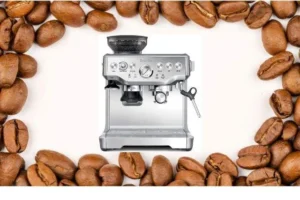Unveiling the Mystery: What is a Cappuccino?
If you have ever found yourself wondering what is a cappuccino, you’ve come to the right place. In this article, we will dive into the world of coffee and uncover the secrets of this beloved beverage. From its definition to its tantalizing taste, we will explore all aspects of a cappuccino, leaving you with a comprehensive understanding of this popular drink.
Key Takeaways
- A cappuccino is a coffee beverage that is made with equal parts espresso, steamed milk, and milk foam.
- It is known for its rich and creamy texture, with a balanced ratio of coffee and milk.
- Cappuccinos can be enjoyed plain or flavored with syrups such as vanilla or caramel.
- The name “cappuccino” is derived from the Capuchin friars, who wore brown robes similar in color to the beverage.
- Traditionally, cappuccinos are served in small cups and are often enjoyed as a morning or mid-day pick-me-up.

The Intricate Process of Making a Cappuccino
Making a cappuccino involves a careful balance of high-quality ingredients and skilled craftsmanship. It all starts with the perfect shot of espresso, which forms the foundation of this classic coffee beverage. To make the espresso, finely ground coffee beans are packed into a portafilter and inserted into an espresso machine. The machine then forces hot water through the coffee grounds under high pressure, extracting the rich and aromatic flavors.
Once the espresso is ready, the next step is to steam and froth the milk. This is where the artistry of the barista comes into play. Cold milk is poured into a pitcher, and a steam wand is used to heat and inject air into the milk, creating a velvety and creamy texture. The barista must carefully control the steam and adjust the positioning of the wand to achieve the desired consistency.
Finally, it’s time to assemble the cappuccino. A shot of espresso is poured into a cup, followed by an equal amount of steamed milk. The final touch is adding a layer of frothed milk on top, creating that signature cap of foam. The barista may choose to sprinkle a dash of cocoa or cinnamon on the foam for an extra touch of flavor and visual appeal.
| Ingredients | Instructions |
|---|---|
| Espresso | Prepare a shot of espresso using finely ground coffee beans and an espresso machine. |
| Milk | Pour cold milk into a pitcher and steam it using a steam wand until it reaches the desired temperature and consistency. |
| Cup | Pour the espresso shot into a cup, followed by an equal amount of steamed milk. Add a layer of frothed milk on top. |
| Optional: | Sprinkle cocoa or cinnamon on the foam for added flavor and garnish. |
Achieving the Perfect Cappuccino
To create the perfect cappuccino, there are a few key factors to consider. First, the quality of the ingredients is crucial. From the freshness of the coffee beans to the richness of the milk, using high-quality ingredients will enhance the overall taste and experience.
Secondly, the brewing process must be executed with precision. The espresso should be extracted at the right temperature and pressure, resulting in a well-balanced and flavorful shot. Similarly, the milk should be steamed to the ideal temperature and texture, creating a creamy and silky consistency.
Lastly, the presentation of the cappuccino is important. The layers of espresso, steamed milk, and frothed milk should be distinct and visually appealing. Taking the time to perfect the technique of pouring and frothing will ensure that each cappuccino is a work of art.
Exploring the Tantalizing Taste of a Cappuccino
A cappuccino offers a harmonious blend of bold espresso, creamy milk, and velvety foam, resulting in a truly indulgent flavor experience. This classic Italian beverage is beloved around the world for its rich and satisfying taste. Whether enjoyed as a morning pick-me-up or a luxurious treat, cappuccino never fails to delight the senses.
One of the defining characteristics of a cappuccino is the balance between strong espresso and smooth, frothy milk. The bold espresso provides a robust and intense flavor, while the creamy milk adds a silky sweetness to the mix. Topped with velvety foam, the cappuccino offers a delightful textural contrast that enhances the overall taste.
While the traditional cappuccino is made with equal parts espresso, steamed milk, and foam, there are countless variations available to suit different preferences. Some coffee connoisseurs prefer a stronger coffee flavor with less milk, resulting in what is known as a “dry cappuccino.” Others may opt for a “wet cappuccino,” which features more milk and less foam. Additionally, creative baristas often add unique flavors such as caramel, vanilla, or chocolate to create personalized cappuccino creations.
| Key Features | Description |
|---|---|
| Espresso | The strong and concentrated coffee base that forms the foundation of a cappuccino. |
| Steamed Milk | Creamy and smooth, the steamed milk adds a velvety texture and sweetness to the cappuccino. |
| Foam | The frothy, airy layer on top of a cappuccino that provides a luxurious mouthfeel and enhances the taste. |
| Variations | From dry to wet, flavored to decaf, there are endless possibilities for customizing a cappuccino to suit individual preferences. |
“A cappuccino is like a symphony of flavors, with each element playing a vital role in creating a truly satisfying coffee experience.” – Coffee Lover
Whether you enjoy the classic cappuccino recipe or prefer to explore the world of unique variations, one thing is certain: the tantalizing taste of a well-made cappuccino is sure to please even the most discerning coffee aficionado. So go ahead, indulge in this delightful coffee beverage and savor every sip of its exquisite flavors.
The Fascinating History of Cappuccino

The history of cappuccino dates back centuries, with roots deeply embedded in Italian coffee culture. Legend has it that this delightful beverage was named after the Capuchin friars, as the color of the coffee resembled the brown hooded robes they wore. The term “cappuccino” first appeared in the 18th century, but it wasn’t until the 20th century that it gained widespread popularity.
Coffeehouses in Vienna and Milan played integral roles in the evolution of cappuccino. In Vienna, the beverage was traditionally made with equal parts coffee, cream, and sugar, creating a velvety smooth concoction. Meanwhile, in Milan, baristas experimented with different ratios of espresso, steamed milk, and foamed milk, giving birth to the classic cappuccino we know today.
With the rise of espresso machines in the mid-20th century, cappuccino became more accessible and began to spread beyond Italy’s borders. The beverage’s popularity soared in the United States during the 1980s, thanks to the emergence of specialty coffee shops that served delicious cappuccinos with intricate latte art. Since then, cappuccino has continued to captivate coffee enthusiasts around the globe with its rich history and delightful flavor.
| Key Milestones | Year |
|---|---|
| The term “cappuccino” is first used to describe a coffee beverage | 18th century |
| Coffeehouses in Vienna and Milan play a role in cappuccino’s evolution | 19th century |
| Espresso machines become more widespread, making cappuccino more accessible | Mid-20th century |
| Cappuccino gains popularity in the United States | 1980s |
Cappuccino vs Latte: Understanding the Difference
While both cappuccino and latte are espresso-based drinks, they each have unique characteristics that set them apart. Let’s delve into the details and explore the differences between these two beloved coffee beverages.
Cappuccino:
Cappuccino is traditionally served in a smaller cup and consists of equal parts espresso, steamed milk, and milk foam. The espresso provides a strong and bold flavor, while the steamed milk adds a smooth and creamy texture. The milk foam on top adds a frothy and aesthetic touch to the beverage. The balance of these three elements creates a harmonious and well-rounded drinking experience.
Latte:

On the other hand, a latte is typically served in a larger cup and is made with more steamed milk than cappuccino. The espresso-to-milk ratio in a latte leans more toward a higher quantity of milk. This results in a milder coffee flavor and a creamier texture compared to cappuccino. The latte is often topped with a thin layer of milk foam or a sprinkle of cocoa or cinnamon for added flavor.
So, whether you prefer a strong and balanced flavor with a touch of foam (cappuccino) or a milder and creamier experience with a larger amount of milk (latte), you can enjoy the pleasure of sipping your favorite espresso-based beverage to suit your taste preferences.
| Cappuccino | Latte |
|---|---|
| Equal parts espresso, steamed milk, and milk foam | More steamed milk, less foam |
| Strong and bold flavor | Milder coffee flavor |
| Smaller serving size | Larger serving size |
Next time you step into a coffee shop, armed with this knowledge, you can confidently order your desired espresso-based drink – whether it’s a cappuccino or a latte – knowing exactly what sets them apart and which one suits your taste buds best. Cheers to enjoying the rich and diverse world of coffee!
Conclusion
Through this exploration, we have unraveled the mystery of what a cappuccino truly is, discovering its origins, taste, and how to craft it to perfection. From its humble beginnings in Italy, the cappuccino has become a beloved coffee choice worldwide. With its smooth and velvety texture, combined with the perfect balance of espresso, steamed milk, and frothy milk foam, the cappuccino offers a delightful taste experience that is both rich and robust.
Whether enjoyed in a traditional Italian café or created in the comfort of your own home, the cappuccino is a beverage that brings warmth and satisfaction with every sip. Its enticing flavors can be enhanced and customized with a variety of syrups, spices, or even a sprinkle of cocoa powder on the foam. The possibilities are endless, allowing you to tailor your cappuccino to suit your personal taste preferences.
As we delved into the fascinating history of the cappuccino, we discovered how it has evolved over time, adapting to different cultures and preferences. Today, the cappuccino remains a classic favorite, loved by coffee enthusiasts around the globe.
Lastly, we compared the cappuccino to its close cousin, the latte, and highlighted their differences in terms of ingredients, preparation, and taste. While both are delicious espresso-based beverages, the cappuccino stands out with its signature milk foam on top, providing a distinct visual appeal and unique flavor profile.
In conclusion, the cappuccino is more than just a coffee drink—it is a symbol of indulgence and craftsmanship. So next time you order a cappuccino, take a moment to appreciate the artistry behind it, and savor each sip as it takes you on a journey of flavor and delight.
What is a Cappuccino? FAQs
A cappuccino is a type of coffee beverage that is made with equal parts espresso, steamed milk, and frothed milk. It is known for its rich and creamy texture and is often topped with a sprinkle of cocoa powder or cinnamon.
To make a cappuccino, you start by brewing a shot of espresso. Then, you heat equal parts of milk and foam, either using a steam wand or a milk frother. Finally, you pour the steamed milk over the espresso, followed by a dollop of foam on top.
A cappuccino has a bold and robust flavor with a balanced combination of espresso and creamy milk. It is often described as having a smooth and velvety texture, with hints of sweetness and a subtle bitterness from the espresso.
Cappuccino originated in Italy and its name is derived from the Capuchin friars, whose brown robes resemble the color of a cappuccino. It gained popularity in Europe during the 20th century and eventually spread to become one of the most beloved coffee beverages globally.
The main difference between a cappuccino and a latte lies in the ratio of espresso, steamed milk, and foam. A cappuccino has equal parts of each, whereas a latte has more steamed milk and less foam. This results in a creamier and milder taste compared to a cappuccino.








